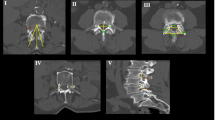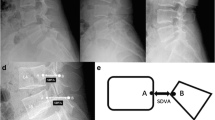Abstract
The objective is to evaluate the geometric parameters of vertebral bodies and intervertebral discs in spinal segments adjacent to spondylolysis and spondylolisthesis. This pilot cross-sectional study was an ancillary project to the Framingham Heart Study. The presence of spondylolysis and spondylolisthesis as well as measurements of spinal geometry were identified on CT imaging of 188 individuals. Spinal geometry measurements included lordosis angle, wedging of each lumbar vertebra and intervertebral disc. Last measurements were used to calculate ΣB, the sum of the lumbar L1–L5 body wedge angles; and ΣD, the sum of the lumbar L1–L5 intervertebral disc angles. Using Wilcoxon–Mann–Whitney test we compared the geometric parameters between individuals with no pathology and ones with spondylolysis (with no listhesis) at L5 vertebra, ones with isthmic spondylolisthesis at L5–S1 level, and ones with degenerative spondylolisthesis at L5–S1 level. Spinal geometry in individuals with spondylolysis or listhesis at L5 shows three major patterns: In spondylolysis without listhesis, spinal morphology is similar to that of healthy individuals; In isthmic spondylolisthesis there is high lordosis angle, high L5 vertebral body wedging and very high L4–5 disc wedging; In degenerative spondylolisthesis, spinal morphology shows more lordotic wedging of the L5 vertebral body, and less lordotic wedging of intervertebral discs. In conclusion, there are unique geometrical features of the vertebrae and discs in spondylolysis or listhesis. These findings need to be reproduced in larger scale study.



Similar content being viewed by others
References
Izumi Y, Kumano K (2001) Analysis of sagittal lumbar alignment before and after posterior instrumentation: risk factor for adjacent unfused segment. Eur J Orthop Surg Traumatol 1:9–13
Lazennec JY, Ramare S, Arafati N, Laudet CG, Gorin M, Roger B, Hansen S, Saillant G, Maurs L, Trabelsi R (2000) Sagittal alignment in lumbosacral fusion: relations between radiological parameters and pain. Eur Spine J 9:47–55
Boulay C, Tardieu C, Hecquet J, Benaim C, Mouilleseaux B, Marty C, Prat-Pradal D, Legaye J, Duval-Beaupere G, Pelissier J (2006) Sagittal alignment of spine and pelvis regulated by pelvic incidence: standard values and prediction of lordosis. Eur Spine J 15:415–422. doi:10.1007/s00586-005-0984-5
Meyerding HW (1932) Spondyloptosis. Surg Gynaecol Obstet 54:371–377
Vialle R, Levassor N, Rillardon L, Templier A, Skalli W, Guigui P (2005) Radiographic analysis of the sagittal alignment and balance of the spine in asymptomatic subjects. J Bone Joint Surg Am 87:260–267. doi:10.2106/JBJS.D.02043
Mac-Thiong JM, Wang Z, de Guise JA, Labelle H (2008) Postural model of sagittal spino-pelvic alignment and its relevance for lumbosacral developmental spondylolisthesis. Spine (Phila Pa 1976) 33:2316–2325. doi:10.1097/BRS.0b013e318186b236
Chen IR, Wei TS (2009) Disc height and lumbar index as independent predictors of degenerative spondylolisthesis in middle-aged women with low back pain. Spine (Phila Pa 1976) 34:1402–1409. doi:10.1097/BRS.0b013e31817b8fbd
Rosenberg NJ (1975) Degenerative spondylolisthesis. Predisposing factors. J Bone Joint Surg Am 57:467–474
Saraste H, Brostrom LA, Aparisi T (1984) Prognostic radiographic aspects of spondylolisthesis. Acta Radiol Diagn (Stockh) 25:427–432
Saraste H, Brostrom LA, Aparisi T (1984) Radiographic assessment of anatomic deviations in lumbar spondylolysis. Acta Radiol Diagn (Stockh) 25:317–323
Huang KY, Lin RM, Lee YL, Li JD (2009) Factors affecting disability and physical function in degenerative lumbar spondylolisthesis of L4–5: evaluation with axially loaded MRI. Eur Spine J 18:1851–1857. doi:10.1007/s00586-009-1059-9
Feinleib M, Kannel WB, Garrison RJ, McNamara PM, Castelli WP (1975) The Framingham Offspring Study. Design and preliminary data. Prev Med 4:518–525
Splansky GL, Corey D, Yang Q, Atwood LD, Cupples LA, Benjamin EJ, D’Agostino RB Sr, Fox CS, Larson MG, Murabito JM, O’Donnell CJ, Vasan RS, Wolf PA, Levy D (2007) The third generation cohort of the National Heart, Lung, and Blood Institute’s Framingham Heart Study: design, recruitment, and initial examination. Am J Epidemiol 165:1328–1335. doi:10.1093/aje/kwm021
Kalichman L, Kim DH, Li L, Guermazi A, Berkin V, Hunter DJ (2009) Spondylolysis and spondylolisthesis: prevalence and association with low back pain in the adult community-based population. Spine (Phila Pa 1976) 34:199–205. doi:10.1097/BRS.0b013e31818edcfd
Kalichman L, Kim DH, Li L, Guermazi A, Hunter DJ (2010) Computed tomography-evaluated features of spinal degeneration: prevalence, intercorrelation, and association with self-reported low back pain. Spine J 10:200–208. doi:10.1016/j.spinee.2009.10.018
Krupski W, Majcher P, Tatara MR (2004) Computed tomorgaphy diagnostic of lumbar spondylolysis. Ortop Traumatol Rehabil 6:652–657. 15748 [pii]
Teplick JG, Laffey PA, Berman A, Haskin ME (1986) Diagnosis and evaluation of spondylolisthesis and/or spondylolysis on axial CT. AJNR Am J Neuroradiol 7:479–491
Been E, Barash A, Pessah H, Peleg S (2010) A new look at the geometry of the lumbar spine. Spine (Phila Pa 1976) 35:E1014–E1017. doi:10.1097/BRS.0b013e3181ddd433
De Carvalho DE, Soave D, Ross K, Callaghan JP (2010) Lumbar spine and pelvic posture between standing and sitting: a radiologic investigation including reliability and repeatability of the lumbar lordosis measure. J Manipulative Physiol Ther 33:48–55. doi:10.1016/j.jmpt.2009.11.008
Kimura S, Steinbach GC, Watenpaugh DE, Hargens AR (2001) Lumbar spine disc height and curvature responses to an axial load generated by a compression device compatible with magnetic resonance imaging. Spine (Phila Pa 1976) 26:2596–2600
Labelle H, Roussouly P, Chopin D, Berthonnaud E, Hresko T, O’Brien M (2008) Spino-pelvic alignment after surgical correction for developmental spondylolisthesis. Eur Spine J 17:1170–1176. doi:10.1007/s00586-008-0713-y
Hefti F, Brunazzi M, Morscher E (1994) Natural course in spondylolysis and spondylolisthesis. Orthopade 23:220–227
Mauch F, Jung C, Huth J, Bauer G (2010) Changes in the lumbar spine of athletes from supine to the true-standing position in magnetic resonance imaging. Spine (Phila Pa 1976) 35:1002–1007. doi:10.1097/BRS.0b013e3181bdb2d3
Colombini A, Lombardi G, Corsi MM, Banfi G (2008) Pathophysiology of the human intervertebral disc. Int J Biochem Cell Biol 40:837–842. doi:10.1016/j.biocel.2007.12.011
Natarajan RN, Andersson GB (1999) The influence of lumbar disc height and cross-sectional area on the mechanical response of the disc to physiologic loading. Spine (Phila Pa 1976) 24:1873–1881
Urban JPG, Winlove CP (2007) Pathophysiology of the intervertebral disc and the challenges for MRI. J Magn Reson Imaging 25:419–432
Chen YL (1999) Geometric measurements of the lumbar spine in Chinese men during trunk flexion. Spine (Phila Pa 1976) 24:666–669
Acknowledgments
From the Framingham Heart Study of the National Heart Lung and Blood Institute of the National Institutes of Health and Boston University School of Medicine. This work was supported by the National Heart, Lung and Blood Institute’s Framingham Heart Study contract (No. N01-HC-25195) for the recruitment, enrollment, and examination of the Offspring and Third Generation Cohort and the imaging by computed tomography scan. Dr Hunter is funded by an Australian Research Council Future Fellowship.
Conflict of interest
None of the authors have any conflict of interest regarding the contents of this article.
Author information
Authors and Affiliations
Corresponding author
Rights and permissions
About this article
Cite this article
Been, E., Li, L., Hunter, D.J. et al. Geometry of the vertebral bodies and the intervertebral discs in lumbar segments adjacent to spondylolysis and spondylolisthesis: pilot study. Eur Spine J 20, 1159–1165 (2011). https://doi.org/10.1007/s00586-010-1660-y
Received:
Revised:
Accepted:
Published:
Issue Date:
DOI: https://doi.org/10.1007/s00586-010-1660-y




